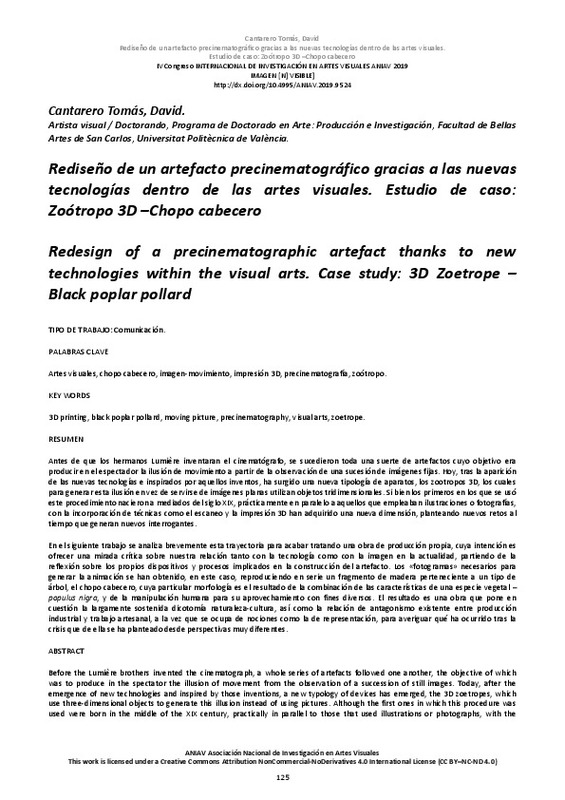|
Resumen:
|
[ES] Antes de que los hermanos Lumière inventaran el cinematógrafo, se sucedieron toda una suerte de artefactos cuyo objetivo era
producir en el espectador la ilusión de movimiento a partir de la observación de una sucesión ...[+]
[ES] Antes de que los hermanos Lumière inventaran el cinematógrafo, se sucedieron toda una suerte de artefactos cuyo objetivo era
producir en el espectador la ilusión de movimiento a partir de la observación de una sucesión de imágenes fijas. Hoy, tras la aparición
de las nuevas tecnologías e inspirados por aquellos inventos, ha surgido una nueva tipología de aparatos, los zootropos 3D, los cuales
para generar esta ilusión en vez de servirse de imágenes planas utilizan objetos tridimensionales. Si bien los primeros en los que se usó
este procedimiento nacieron a mediados del siglo XIX, prácticamente en paralelo a aquellos que empleaban ilustraciones o fotografías,
con la incorporación de técnicas como el escaneo y la impresión 3D han adquirido una nueva dimensión, planteando nuevos retos al
tiempo que generan nuevos interrogantes.
En el siguiente trabajo se analiza brevemente esta trayectoria para acabar tratando una obra de producción propia, cuya intención es
ofrecer una mirada crítica sobre nuestra relación tanto con la tecnología como con la imagen en la actualidad, partiendo de la
reflexión sobre los propios dispositivos y procesos implicados en la construcción del artefacto. Los «fotogramas» necesarios para
generar la animación se han obtenido, en este caso, reproduciendo en serie un fragmento de madera perteneciente a un tipo de
árbol, el chopo cabecero, cuya particular morfología es el resultado de la combinación de las características de una especie vegetal –
populus nigra, y de la manipulación humana para su aprovechamiento con fines diversos. El resultado es una obra que pone en
cuestión la largamente sostenida dicotomía naturaleza-cultura, así como la relación de antagonismo existente entre producción
industrial y trabajo artesanal, a la vez que se ocupa de nociones como la de representación, para averiguar qué ha ocurrido tras la
crisis que de ella se ha planteado desde perspectivas muy diferentes.
[-]
[EN] Before the Lumière brothers invented the cinematograph, a whole series of artefacts followed one another, the objective of which
was to produce in the spectator the illusion of movement from the observation of a ...[+]
[EN] Before the Lumière brothers invented the cinematograph, a whole series of artefacts followed one another, the objective of which
was to produce in the spectator the illusion of movement from the observation of a succession of still images. Today, after the
emergence of new technologies and inspired by those inventions, a new typology of devices has emerged, the 3D zoetropes, which
use three-dimensional objects to generate this illusion instead of using pictures. Although the first ones in which this procedure was
used were born in the middle of the XIX century, practically in parallel to those that used illustrations or photographs, with the incorporation of techniques such as 3D scanning and 3D printing, they have acquired a new dimension, posing new challenges while
generating new questions.
In the following work we briefly analyse this trajectory to end up dealing with a work of own production, whose intention is to offer a
critical perspective on our relationship both with technology and with the image nowadays, starting from the reflection on the own
devices and processes involved in the construction of the artifact. The «frames» necessary to generate the animation have been
obtained, in this case, reproducing in series a fragment of wood belonging to a type of tree, the black poplar pollard, whose peculiar
morphology is the result of the combination of the characteristics of a plant species –populus nigra, and human manipulation for its
use for various purposes. The result is a work that calls into question the long-held nature-culture dichotomy, as well as the existing
antagonistic relationship between industrial production and craftwork, while dealing with notions such as representation, to find out
what happened after its crisis as has arisen from very different perspectives.
[-]
|








